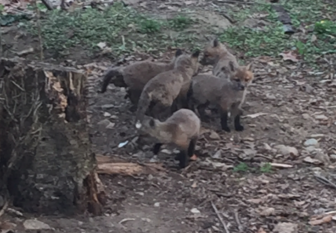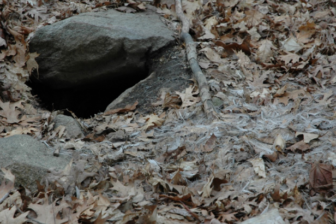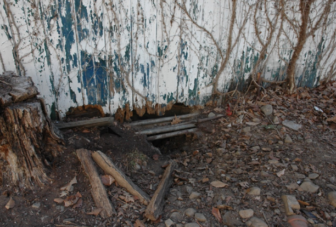The New Canaan Police Department’s Animal Control section has received five reports of fox dens in town over the past several days, officials say—an annual surge in activity following the birth of “kits” that should cause residents no alarm, according to wildlife experts.

A total of eight fox kits were counted at a den at Lakeview Cemetery. This photo taken April 21, 2016, and published with permission from its owner
Sightings have been reported at Lakeview Cemetery as well as on Brushy Ridge, Canoe Hill and Lone Tree Farm Roads, Animal Control Officer Allyson Halm said.
Now about eight weeks old, the red fox kits are strong enough to venture forth from the dens made by their parents, both of whom continue to forage for food and bring it back to litters that average five to eight babies, she said.
Foxes prey on chipmunks, mice, squirrels and goose eggs and “are very good for the environment,” Halm said.

Fox den off of Lone Tree Farm Road. Photo published with permission from its owner
“They are extremely adaptable and, if left alone, they are basically part of the landscape,” she said.
They also kill and consume large “woodland rats” that have a very rapid population growth—10 babies in 30 days—which would “infest an area” and “run rampant” if not for their predators, according to Peter Reid, associate director of Wildlife in Crisis, a Weston-based nonprofit organization dedicated to wildlife preservation and land conservation. (About 10 percent of the fox diet consists of insects, he said.)
“Foxes serve an important role with the re-forestation of this area—there’s more opportunity for rodents and other small mammals, and foxes fill a niche to balance things out,” he said.

A fox den under a shed at Lakeview Cemetery. Photo published with permission from its owner
They pose no threat to humans or dogs, though—as with many other types of wildlife (for example, bobcats or coyotes)—they can be dangerous for free-roaming cats and domestic cats when they’re outside, Reid said. Foxes also are a “rabies vector species,” he said—meaning that they can get rabies, like cats or dogs (the incidence is low and symptoms are very clear), though they do not “carry” rabies.
“People should not have a blanket fear of the fox,” Reid said.
Around this time of year, numerous reports of fox sightings come in because the animals are “denning” and the animals at about eight weeks “suddenly emerged on a nice day and are playing and gamboling around in a yard,” Reid said.
“Once the kits are large enough, they are essentially little puppies and this is when you usually see them and some become alarmed by their presence,” he said.
By midsummer, fox sightings will again become rare, he said.
The reason foxes are denning so closely to humans now is because “coyotes have become the kings of the woodland, and foxes are in closer proximity to human homes because it’s safer there,” Reid said.
Coyotes will attack and kill a fox if it’s in their range, so over the past several years, foxes have been denning far closer to humans than before—under sheds and decks “and within 20 feet of the front door.”
Historically, the species has been in this area since the 1700s—coming down from Canada after colonists cleared land here (they like open terrain) and brought over by the British, too, who hunted them. There’s no red fox in the fossil record for this area prior to 1650, Reid said.
“They thrived when this became farm country and when a lot of other animals were being pretty much eliminated—by 1850, there was not much wildlife here—the foxes were thriving, hunting rodents,” he said. “That’s why they love England, all the fields and hedgerows.”
According to the Connecticut Department of Energy and Environmental Protection, foxes typically keep more than one den and may move if they’re disturbed. Both parents—and this is unusual for males—bring food to their young and guard a den site, the DEEP said. The young will disperse from the family unit in the fall and typically breed during their first winter.
I saw two foxes on Soundview Lane last weekend. Such beautiful animals. Happy to have them in my neighborhood.
Agree. I moved to this part of town for the natural beauty. Enjoy seeing all animals especially the orange fox who has not been around for a while. Why people get concerned over every animal sighting is beyond comprehension. Perhaps they would be better living in an urban setting. FYI the animals were here first. We are the intruders.
Three days ago, by 7 pm, I was doing some gardening in the front yard, on Brush Ridge Rd, when all suddenly I turned to the right and saw this gorgeous big red fox with a long brown spot in his bushy tail. He ran up the hill. It was a nice experience! Quite unusual!